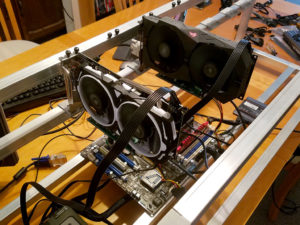
Building an open-frame GPU miner.
It’s finally time for an update to my popular 2013 Litecoin mining guide! It’s four years later, and Ethereum mining is where it’s at for GPU miners, so that’s what I’ve focused on. I’ve kept the same format and detail level as my old guide, so if you were around back then, you’ll know what to expect.
If you’re new to the world of crytocurrency mining, this guide should give even an absolute beginner all of the knowledge needed to put together an efficient Ethereum (or other GPU-minable altcoin) mining rig using readily-available consumer hardware.
This guide will be broken into several parts, each focusing on a different aspect of building your first mining rig. First, let’s take a look at what you’ll need in terms of hardware to put a respectable Ethereum miner together.
Build your own Ethereum Mining Rig, part 1: Hardware
Here is the list of hardware that I recommend. Don’t worry if you’re not able to get exactly what’s on this list, I provide some excellent alternatives below the table.
| Motherboard | 1 x Asus B250 Mining Expert | $180 |
| Processor | 1 x Intel Celeron G3900 CPU | $45 |
| Memory | 1 x 4GB DDR4 DIMM | $40 |
| Power Supply | 1 x 1200w Platinum PSU | $260 |
| GPUs | 3+ Radeon RX 570 video cards (*see below) | ~$200 each |
| Boot Device | 1 x 60GB SSD -or- USB stick (Linux) | $5 – $35 |
| Case | 1 x build your own (see bottom) -or- open frame case | $30 – $200 |
Some explanations and alternatives for each item:
Motherboard
Generally, any motherboard with PCIe slots on it is suitable for mining—typically one GPU per PCIe slot. The PCIe slots don’t need to be full-length, as we can attach GPUs to 1x slots with the help of risers. With that said, there are potentially some limitations when you start to pack a large number (4+) of GPUs onto one motherboard, even if that board has enough PCIe slots to physically accommodate them. That’s why picking a suitable motherboard is probably your biggest hardware headache if you want to run as many GPUs as possible in your rig.
My top choice is currently the Asus B250 Mining Expert board. It’s literally made for mining, with support for up to 19 (!) GPUs and 3 power supplies right out of the box. Even if you don’t intend to initially run more than a few GPUs, the included mining-centric diagnostic features and ability to expand later probably make the price premium over less-robust boards worth it.
The ASRock H110 Pro BTC+ is another excellent choice for mining, with support for up to 13 GPUs. However, it currently costs about the same as Asus’s mining board, and for the money I’d rather stick with Asus. If you know that you’ll definitely stick to a single PSU and a small handful of GPUs (e.g.: the majority of us), this is a fine choice, especially if you find a deal on it.
Finally, the Biostar TB250-BTC is also aimed at miners, and costs considerably less than the Asus and ASRock offerings. The Biostar board “only” supports 6 GPUs, but that’s likely all that the majority of us need. If price is your primary consideration, the TB250-BTC should be at the top of your list for 6 GPU rig builds.
If you only want to use 3-4 GPUs in your rig, then you’ll have a much easier time. Most boards with up to four PCIe slots should accommodate a GPU in each. Keep in mind that you can use old hardware that you have sitting around—the board doesn’t have to be recent. I dug out an old ASRock 970 Extreme4 that I used four years ago for litecoin mining, and it still works fine today for up to 4 GPUs (5 is possible with some work). So it’s possible to pick up an ancient board on eBay/Craigslist for nearly nothing and mine with less than 6 video cards.
CPU / Processor
This one is easy: buy the cheapest CPU that works with whatever motherboard you pick. When it comes to mining, the GPUs do all the work. Your CPU will essentially sit idle, so there is no reason to waste money on anything other than the bare minimum.
All of the motherboards that I recommended based on Intel’s LGA 1151 socket, so that means the Celeron G3900 is probably the best choice.
If you go with an AMD motherboard, a Sempron CPU will do nicely.
Memory
4GB is fine. Overkill really, at least for Linux. If you have an old 2GB stick (or even 1GB!) sitting around and plan to run Linux, you’re good to go. If you want to run Windows, then 4GB is probably a realistic minimum.
While Ethereum mining is pretty memory-intensive, everything happens on the GPUs. System memory will be pretty much unused, so there is no reason to spend money here, especially with DDR4 prices so high.
PSU / Power Supply
The power supply is extremely important—don’t skimp on it! A good, efficient PSU will keep your electricity costs to a minimum and more than pay for itself over the long run. Seasonic, EVGA, and Corsair are all generally top brand choices. The 1200W unit that I’ve linked may seem like overkill, but power supplies are most efficient when they’re not running near their rated maximum load. A 6 GPU rig will draw about 750 watts (assuming 6x RX 570 cards, properly optimized), which means a 1200W PSU will have sufficient headroom to perform efficiently.
If you’re planning on running only 3-4 GPUs, you can save a bit of money and go for their 850 watt model instead.
GPUs / Video Cards
The top Ethereum mining choice is currently the Radeon RX 570 / RX 580 line*. The RX 570 delivers nearly the same performance as the RX 580 (within 4-7% or so) for a bit less power consumption—they’re essentially equal from an efficiency standpoint. The RX 570 is usually significantly cheaper than the 580, so generally the 570 is the best choice.
Which model to pick, though? While literally any RX 570/580 card will do, the most important thing to look for is memory speed if you want the best performance. Cards with a higher memory clock speed will generally perform a bit better while mining ETH (and can generally be overclocked more). Memory capacity isn’t really important beyond 4GB, so all other things being equal, there is no reason to shell out extra cash for the 8GB version of a card. It’s true that every GPU needs to be able to hold Ethereum’s DAG file in memory, and that file is slowly increasing in size—but it won’t surpass 4GB until late 2019 (and ETH’s switch to PoS will likely occur before then, anyway).
With all of that said, the 8GB versions of the cards tend to have faster-clocked memory than most of the 4GB cards, so if the price difference isn’t too large, spring for whatever is the fastest. Most of the cards fall between 1650 Mhz (6600 Mbps effective) to 2000 Mhz (8000 Mbps effective). The slower 1650 Mhz memory GPUs will hash at 21-23 Mh/s, and the fastest 2000 Mhz ones will do 25-28 Mh/s (both can potentially be pushed higher with BIOS mods and good luck).
The best advice is usually to just pick up whichever 570/580 card you can get your hands on for the least money, as mining speed differences between brands/models are pretty small after optimization. These 8GB MSI RX 570 cards are $220 each as of 11/29/2017, and I’m running mine at 28 Mh/sec without pushing them too hard.
If you can still find old RX 470/480 cards on the secondary market, they’re just as good the RX 570/580 cards that replaced them.
*While my guides deal with setting up and optimizing AMD’s GPUs, nVidia’s 1060 / 1070 video cards are also excellent for mining. Generally these days I tend to recommend whichever is cheaper (and right now, that’s AMD). But if you find a deal on some nVidia 1070 GPUs, don’t hesitate to grab them—they perform just as well as AMD’s offerings, and are arguably easier to set up (just remember to install nVidia drivers instead of AMD’s if you follow the rest of my guide!).
Boot Device
If you plan to run Linux, you can use pretty much anything, including a ~$5 16GB USB stick (we’ll be using Claymore miner, which doesn’t write Ethereum’s DAG file to disk, so we don’t need to worry about wearing a USB stick out due to constantly writing to it, like with the stock ethminer). With that said, SSDs are pretty cheap nowadays and it might be nice to have one in case you want to try Windows at some point.
If you plan to run Windows, then a cheap 60GB+ SSD is your best bet. If you have an old mechanical hard drive laying around, that’ll work fine too.
The Case
I highly recommend against trying to cram a bunch of GPUs into a conventional PC case. You have two realistic options here: buy a purpose-built mining frame, or build something yourself.
The first option is straightforward, if not a bit more expensive. Here is an example of an open-air frame that will accommodate up to 6 GPUs. Here’s another option. You’ll pay a premium going this route, but it’ll save you some time and effort.
Building your own is much cheaper, and (arguably) more fun! If you’re handy, you can put together a simple aluminium frame yourself for a fraction of the cost of buying one. If you don’t have the necessary skills or tools for that, I popularized building mining rigs inside plastic crates back in 2013, and that still works fine today (for up to 4 GPUs or so, anyway). At the bottom of this post, you’ll find instructions on how to build a plastic crate “case”.
Risers & Miscellaneous Stuff
If you’re building your own case (whether it’s from a plastic crate, or aluminium, or something else), you’ll need risers to connect your GPUs to your motherboard. If you’re buying a mining frame, most include risers. Risers tend to be pretty misunderstood among new miners, so here is what you need to know:
- Risers can be powered or unpowered. A riser is unpowered if it simply connects a GPU to a motherboard PCIe slot. A riser is powered if it additionally accepts power from the PSU (generally via a molex-type connector). Unpowered risers allow GPUs to receive up to 75 watts of power through the motherboard’s PCIe bus, just as if they were plugged in directly. Powered risers will take that additional power directly from the PSU instead, bypassing the motherboard.
- You may mix unpowered and powered risers, but the total number of unpowered risers should not exceed two (this includes GPUs plugged directly into the motherboard)! Motherboards are generally not designed to deliver more than 150 watts of total power through the PCIe bus, so two GPUs on unpowered risers is the safe maximum (2 x 75 watts).
- The newer USB-style powered risers often include SATA-to-molex power adapters. Throw these adapters away! SATA plugs are not designed to deliver 75 watts safely, and these can get hot enough to potentially be a fire risk (admittedly, 99% of the time you’ll be fine, but it’s not worth the risk). Instead, connect the molex plugs on the riser directly to your PSU (no more than two risers per PSU plug). Newer versions of these USB risers forego the molex adapter and instead use a PCIe connector for power.
I do think the newer USB-style risers are the way to go—they’re longer and easier to work with than the old ribbon-style cables. Here is a 6-pack of USB risers with the newest (and safest) PCIe connectors. It’s always smart to buy an extra or two, as defects are relatively common. If you have older ribbon-type risers laying around, or can get them cheaply, they’ll work just fine.
If you’re building or buying a large frame, you might need extenders for some of your molex plugs and PCIe power plugs.
You’ll also need a power button, unless your motherboard has one built in (which is fairly rare). This will do the trick, or you can build one into your plastic crate if you plan to go that route (see below).
Some people have reported that their rigs won’t boot unless they have a monitor connected, although this seems to be fairly rare (my own rig boots fine without a display attached). If this happens to you, you’ll need a dummy plug.
Building your Mining Rig “Case” from plastic milk crates
(I’ve copied the instructions from my original 2013 guide here and updated them slightly.)
Here is what you’ll need to create a simple DIY plastic crate housing for your miner:
| Plastic milk crate (can stack two and put your PSU in the lower one) | $10 each |
| Plastic stand-offs | $3 |
| 6 x #4 3/8″ wood or metal screws | $1 |
| Brace to rest GPUs on (1″ PVC pipe works great!) | $2 |
| a few cable ties (8″ or so) | $2 |
| power switch & LED (optional) | $5 |
You can get plastic crates in most home improvement stores if you don’t want to ship it from Amazon (it’ll be cheaper, too!). I picked mine up at Lowe’s for under $5 each. You should be able to get everything else on the list at Lowe’s if you happen to have one near you, too. As far as tools go, you’ll need a drill and a knife capable of cutting into whatever plastic crate you buy.
Assembly Steps:
First, attach your CPU & heatsink/fan to your motherboard, and place your RAM into the memory slot(s). Then follow the general steps below to mount everything into your plastic crate.
Click the images for a close-up look at each step.
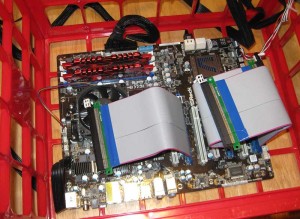 Place plastic standoffs on the bottom of your plastic crate, and rest your motherboard on top of them. Make sure that all of the essential ports are accessible (SATA, USB, keyboard, mouse, etc). Use your knife to cut away pieces of the crate if necessary so that all ports you plan to use are exposed. Then plug your riser cables into the PCI-E slots of your motherboard.
Place plastic standoffs on the bottom of your plastic crate, and rest your motherboard on top of them. Make sure that all of the essential ports are accessible (SATA, USB, keyboard, mouse, etc). Use your knife to cut away pieces of the crate if necessary so that all ports you plan to use are exposed. Then plug your riser cables into the PCI-E slots of your motherboard.
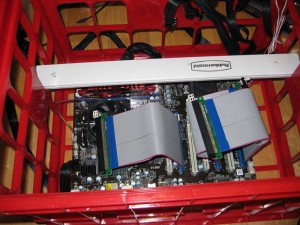 Place your brace (1″ PVC pipe is really ideal and won’t flex over time) so that it is sitting above the motherboard, high enough for your GPUs to rest on. Cut the brace so that an inch or two sticks out on either end of the crate.
Place your brace (1″ PVC pipe is really ideal and won’t flex over time) so that it is sitting above the motherboard, high enough for your GPUs to rest on. Cut the brace so that an inch or two sticks out on either end of the crate.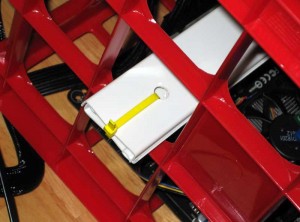 Drill holes in your brace so that you can secure it with cable ties (see image). Do not simply rest the brace on the crate! An accidental bump can cause it to fall into the crate, along with ~$1000 worth of GPUs if you do that!
Drill holes in your brace so that you can secure it with cable ties (see image). Do not simply rest the brace on the crate! An accidental bump can cause it to fall into the crate, along with ~$1000 worth of GPUs if you do that!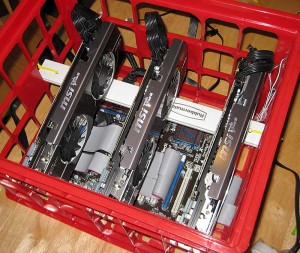 Connect each GPU to it’s corresponding riser cable, resting the bracket end on the lip of the crate and the other end on your brace.
Connect each GPU to it’s corresponding riser cable, resting the bracket end on the lip of the crate and the other end on your brace.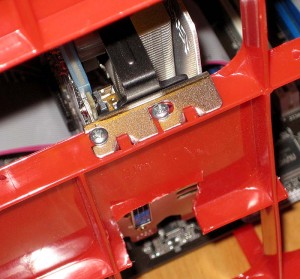 Screw each GPU down into the lip of the crate. If you drill small pilot holes ahead of time (mark where to drill with a sharpie), this is much easier.
Screw each GPU down into the lip of the crate. If you drill small pilot holes ahead of time (mark where to drill with a sharpie), this is much easier.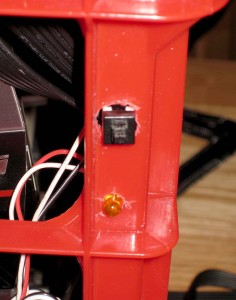 If you have a power switch and LED, mount them into one of the crate’s corners. I was pretty sloppy with mine, but it’s functional.
If you have a power switch and LED, mount them into one of the crate’s corners. I was pretty sloppy with mine, but it’s functional.
You’re done! Simply connect everything to your power supply and you should be ready to power your rig on for the first time. If you have a second crate, you can put your power supply in there (along with your harddrive if you’re using Windows), and stack it under your main crate to save some space.
In the next part of this guide, I’ll show you everything you need to do to start mining under Linux (or skip to the Windows section if that’s more your thing)!



 April 6th, 2017
April 6th, 2017  CryptoBadger
CryptoBadger 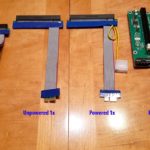
 Posted in
Posted in  Tags:
Tags: 


Hi Everyone,
Would this build still work if I swapped out the gpu for 2-4 1070’s? If so, would I still need a 1200w psu or can I substitute for something else?
Motherboard 1 x ASRock H97 Anniversary $90
Processor 1 x Intel Celeron G1840 CPU $45
Memory 1 x 4GB DDR3 DIMM $20
Power Supply 1 x 1200w Seasonic Platinum $260
GPUs 3-6 x Radeon RX 470 video cards (*see below) ~$180 each
Boot Device 1 x 60GB SSD/ 128 gb ssd
Case 1 x build your own* -or- open frame case $35 – $200
Sorry for the dumb question if it’s already been asked!
Thanks,
Dweeebs
As the Asrock H81 Pro BTC is also becoming hard to find, I’ve heard that the Biostar TB250-BTC is also a good one. It has 6 PCIe slots and so seems ok for mining, they’re a bit more expensive but at the moment I think it might be better to grab one while I can.
Any thoughts on this board?
Yes, the TB250-BTC is a fine choice. I didn’t initially list it in my recommend hardware because it’s a LGA1151 board and requires DDR4 RAM (both slightly more expensive than the older LGA 1150 CPU & DDR3 memory that’s compatible with the other boards I recommended). But given the scarcity of good 6 PCIe boards, I’ll add it to my list.
If you grab one, just make sure to get a LGA1151 Celeron and DDR4 RAM (not the LGA1150 CPU and DDR3 I link in my guide)!
Will the TB250-BTC work fine with 6 1070s? I’ve looked everywhere on the internet to find an individual who has done this but no luck.
The TB250-BTC is one of the newer mining boards, so not as many people have them compared to the ASRock boards. I don’t have one myself, but it was designed and marketed as a board specifically for mining with up to 6 GPUs – so it should work fine.
Also these two? they both seem to have 6 slots available..
Asus-PRIME-Z270-P-Intel-Z270-S-1151-DDR4-SATA3-M-2-PCIe-SATA-2-Way-Cross
Asus-PRIME-B250-PRO-Intel-B250-S-1151-DDR4-SATA3-M-2-PCIe-SATA-2-Way-Cro
Those should be fine too, but will probably require some trial-and-error with BIOS settings to get everything working. The Biostar TB250-BTC was designed as a mining board, and should work well pretty much out of the box.
Hello,
thank you for sharing your experience
please give me your opinion about EVGA GeForce GTX 1050 Ti SC GAMING ?
Excellent tutorial.
Would this card also be OK – https://www.amazon.com/s/ref=nb_sb_noss?url=search-alias%3Delectronics&field-keywords=B01HHCA1IO
Thank you!
Yes, the GTX 1070 is probably the best current substitute for the unavailable RX 570/580.
Hi, first of all I just wanted to say thanks for the guide because it has been an amazing help. I’m brand new to this and it may be a dumb question but would it be better to plug my rig up to a computer or just buying a monitor, keyboard, and mouse? If I need to get a monitor what do you suggest?
If you already have a computer with a monitor/keyboard/mouse, I’d just temporarily borrow those for the initial rig setup. Once you’ve got things up and running, you no longer need a monitor or peripherals for your rig. Management and monitoring can be done remotely via SSH (Linux) or VNC (Windows) from another computer.
Hey CryproBadger!
Thanks for this in-depth tutorial. I’m amazed by how detailed it is. It’s also so awesome that you still reply to all the questions you get. I also have a few since I’ve never mined any cryptocurrencies. I would love to get your insight since you seem to be very knowledgeable on the topic. I’m gonna do my best to put my question in the most condensed form possible:
1. Do you still think it’s worth to start mining at this point or is it too late? (Considering my electricity costs will be almost 0)
2. Are you familiar with this calculator? https://www.cryptocompare.com/mining/calculator/
And if so, do you think the calculations it makes are realistic?
3. (Saved my most stupid question for dessert lol) The hash speeds (21-28Mh/s) are per GPU and not in total, correct?
Even if you don’t answer my questions, you’ve already helped me/us immensely.
Thanks in advance!
Cheers!
I’m feeling a bit ashamed now, since I realize that I rushed to ask questions instead of looking for the info myself. Sorry, I felt a rush to get the information as fast and easy as possible.
I found the answer to question 2 (I saw you even prefered that calculator) and 3 on my own. But I would still be happy to hear your input for my first question.
No worries, there is a lot of info to take in. To answer your last question, yes those hashrate estimates are per GPU. A 6 GPU rig (based on a RX 470/480/570/580 or GTX 1070) will conservatively hash at 150 MH/s or more.
Thanks for the great guide! I’ve got 1 GPU running. I would like to add a few more to my rig but if I connect another GPU the computer won’t post. The computer works when I have 1 GPU in either of the pcie slots. I’m thinking this is because the motherboard isn’t able to run 2 GPUs at the same time? The motherboard is a 0M5DCD that I took out of an old Dell optiplex 390. Any advice would be greatly appreciated!
For the ASROCK 970 extreme4 motherboard where are you putting the 4th GPU? i see 3 of the long blue pcie slots and 2 of the short white pcie slots
Gosh! i wish there was a delete button! u already went over this..This is what the riser cards are for..I was ths close to buying another motherboard…hahah
hello i have a corsair cx750 it is enough for 1 rx480 and 3 rx580 undervolted for eth mining not dual? (less than 85w under gpuz)
750 watts should be enough as long as you undervolt and don’t plan to dual-mine (note that your PSU’s efficiency will suffer a bit by running it at such a high load relatively to its maximum capacity). You’ll probably pull close to 600 watts at wall with that setup. I’d recommend a kill-a-watt meter if you don’t already have one to verify your actual consumption.
Hello everybody,
I’m still searching for decent gpu’s to use for a rig..We talked about the gpu needing only 4gb memory on them..something like this maybe:
EVGA Nvidia GeForce GTX 1050 Ti 4GB SSC GAMING ACX 3.0 Video Card,
now these I can pick up for about £160, but I read somewhere that the 1050’s are slow on mining..
The next step up are the GTX 1060’s, now these all seem to be 6gb:
eg MSI GeForce GTX 1060 6G OC Graphics Card, will retail for £250..
Obviously when you’re trying to put a rig together for the 1st time, you want to do it as cheaply as possible but want it to be as efficient as possible..
Will the 1050’s do the job??
GTX 1050s will work but they will be very slow – the 1060 is a much better choice (and the 1070 is the best choice). It’s much better to buy less GPUs and go with the 1060 or 1070 (you can always add more later) vs buying a bunch of 1050 GPUs.
1060’s it’ll be then, managed to grab a biostar TB250 for a starting point for about £100. Those Asrock H81 are stupid money, they’re going on Ebay for £200+
That’s because everyone knows the huge demand for specific mining boards and gpus.. a lot of countries in EU ran out of stuck and are currently waiting new product shipments..
Couldn’t agree more, I heard new batches are coming in this end of June, there’s a lot of people waiting for GPUs and boards in Europe.
Hello will this board
MSI Z170A GAMING M5 LGA 1151 Intel Z170 HDMI SATA 6Gb/s USB 3.1 ATX Intel Motherboard
Work with the celeron CPU you mentioned. Ima noob at all this stuff. Just thought I’d give mining a try.
That’s a newer socket LGA1151 board, so you’ll need a socket LGA1151 Celeron. Also note that it requires DDR4 memory, not the DDR3 most of the older mining motherboards use.
So just buy some ddr4 ram?
Yup. The RAM I linked in my original reply should work fine with the MSI motherboard you’re considering.
Sweet and it’s red
Would any of the AMD RX570 4GB gpu cards do the job as well?
eg, MSI Radeon RX 570 ARMOR 4G OC Graphics Card..they dotn seem to be out yet and only for preorder, but seem relatively not that expensive £180-£190..
Any thoughts? otherwise its back the the gtx 1060 idea..and buy one or two and build u[p as I go along..
Is the SATA port where i would initially connect the monitor? I have the asrock 970 extreme 4
The monitor gets plugged into the primary video card (typically whichever GPU is occupying the full-length PCIe slot closest to the CPU socket on the motherboard). You can use any of the ports on the video card that are compatible with the monitor you have – most people use the HDMI or DVI port.
Definitely don’t try to plug your monitor into a SATA port. =) If you’re relatively new to the world of PC-building, generally things only fit together if they’re meant to be plugged into each other, so just take your time – there are a bunch of good videos on Youtube aimed at first-time builders, too. Good luck!
Will (1) 2gb dell optiplex DIMM fx160 gx320 Ram memory stick work for mining with linux for mining eth and other cryptos?
Yes, 2GB of memory is enough in Linux. I’m running my own test rig with a single ancient 2GB DIMM.
Love this guide. Got a question, do I need any more cables or adapters for the psu and gpu or does the psu come with the necessary cables to hook everything up?
Here’s the PSU, GPU’s, and Motherboard I’m getting. I would greatly appreciate the reply!
https://www.amazon.com/dp/B00EKJQM5E/ref=cm_sw_r_cp_api_gZ1rzb8BMD9P9
https://www.amazon.com/dp/B01HHCA1IO/ref=cm_sw_r_cp_api_td2rzbRE6X3V0
https://www.amazon.com/dp/B06Y3NDXLH/ref=cm_sw_r_cp_api_Cc2rzb2C65R03
Those will all work fine together. If you’re planning to run more than 4 GPUs, consider stepping up to a 1200 watt PSU (especially if you’re going to dual-mine) – it’ll run more efficiently.
No need for any additional cables unless you’re planning to locate the PSU far away from the GPUs.
Hi Everybody..
sorry to harp on about these gpus..would these rx 570s do the job?..
eg.
MSI Radeon RX 570 ARMOR 4G OC Graphics Card..they dotn seem to be out yet and only for preorder, but seem relatively not that expensive £180-£190..
thanks for any help..
Yes, any RX 570 is a great choice – if you can find them. They were released a couple months ago, but they’ve been sold out virtually everywhere for awhile now. They’re most likely backordered whenever you’re trying to acquire them from. If you can get your hands on them for that price, absolutely go for it – they’re selling for at least twice that much used.
Howdy, I have a GPU that the manual says needs 2 x 6 Pin PCIE connectors.
(EVGA GeForce GTX 1070 FTW GAMING ACX 3.0)
I have a breakout board for a 1200 watt HP server power supply.
I’m short of connections on the breakout board. Can I combine 2 x 6 pin connectors into 1?
Possibly with some thicker gauge wire?
Thank you for any advice =)
Sorry my bad. It is actually 2X8PIN at the GPU with a converter cable to 1X6 PIN for the PSU.
I guess that the 1X6 PIN is the limiting factor?..
Hello,
So a quick question about risers. If I user unpowered ribbon type riser, and power the GPU directly from the PSU with the 6-8pin connector, will that be equal to using a powered riser? Also, I have a ribbon riser with a molex connector, currently not using it and just plugging in the power from the PSU.
Thanks!
GPUs always need power from the PSU via the 6/8 pin PCIe connectors built onto the card – they won’t run at all if you don’t plug those in.
If a riser doesn’t have a power connector attached to it (eg: usually just a simple ribbon cable), it’s unpowered – it works pretty much the same as plugging the GPU directly into the motherboard. The motherboard will supply up to 75 watts of additional power to the GPU through the PCIe socket (this is in addition to the power supplied through the 6/8 pin PCIe plugs).
If a riser has a molex power connector attached to it, it’s a powered riser – that additional 75 watts of power no longer needs to be supplied through the motherboard PCIe socket, it can be delivered through the riser’s molex connector instead. That’s great, because motherboards really weren’t designed to supply more than 2-3 GPUs with power through the PCIe sockets. If you don’t plug a powered riser in, it’ll work just like an unpowered riser.
Basically – you want to plug your powered risers in, to reduce the amount of power that has to be supplied to your GPUs through the PCIe bus. It’s ok to use a couple (2) unpowered risers at most – more than that is potentially dangerous.
Hi, thank you for the awesome guide. I’m wondering if this guide works for mining Litecoin now?? or is this specific for Ethereum?
I think its too late to mine for litecoin…Because they already went to POW…im like 60% sure though
I have a Litecoin-specific mining guide that I wrote in 2013 here. While it should still work, I don’t recommend that anyone try to mine LTC with GPUs. Specialized ASIC hardware (eg: like this) has made GPU mining (for scrypt/Litecoin) basically obsolete.
I got one of the Bundles for 8 GPU from GPUSHACK and it came with a MSI Z170A Gaming 5 motherboard. I have everything hooked up (correctly I though) but can only get 5 GPU’s to be recognized. Can anyone provide any direction on a fix or tip on what I may have done wrong?
Thanks for this post, very informative. Do you have any posts on how to update the bios? I have a gigabyte GA-Z97X-GAMING 3 LGA 1150 Z97 with risers but after plugging in the third gpu the cpu won’t start. Lots of posts on how to build a rig but not much on what to do once it built 🙂
Hi Cryptobadger. I just thought to give ETH mining a try. Please could you help me out.
Kindly let me know if I could use my existing PC components or will I require to buy a new one.
Below are the components I have. :-
1) Asus P5G41T-M LX motherboard
2) Intel core to duo processor.
3) 500gb HDD
4) 4GB DDR3 Ram
4) 450W PSU
I would like to start off with 1 or 2 GPU’s ( either RX570 or GTX 1070 )
Please let me know whether any of my existing components would come in use. Thanks!
You should be able to use all of that. The 450 watt PSU should be able to handle two RX 570 or GTX 1070 cards (possibly three if you undervolt aggressively, but it’s probably better to upgrade the power supply if/when you plan to run 3+ GPUs).
Hi, i have TB250-BTC motherboard and intel G3930 processor, Biostar says to update bios before i install processor in their guide, How can I update bios without installing processor?
thanks.
Cryptobadger, I purchase all the parts listed (actually got 3 rx470/ a few weeks back). Anyway my rig is this one:
http://www.parallelminer.com/product/all-aluminium-6-1-gpu-open-air-mining-case-w-6-usb-risers-1-1200w-psu-kit-eth-zec/
And it came with these wires:
1x REV1 KADA 6.1 all aluminium frame
6x ITHOO PCI-E Riser cards
6x USB 3.0 50cm cables
6x Molex to SATA Power Cables
1x 80+ Platinum 94% efficiency HP 1200 Watt Power Supply
8x 24in 16AWG 6 Pin Male to 8 Pin (6+2) Male PCIE cable
I believe I still need to purchase a 24 to 6 pin power cable for the motherboard and a 4 to 6 pin cable for the CPU. Does that sound right?
Considering this one:
http://www.parallelminer.com/product/160watt-24pin-atx-power-module-included-sata-molex-cpu-power-connectors-bypass-your-atx-power-supply-entirely/
That looks right to me.